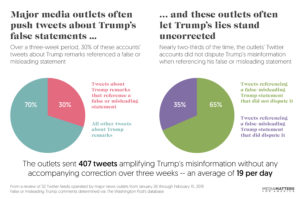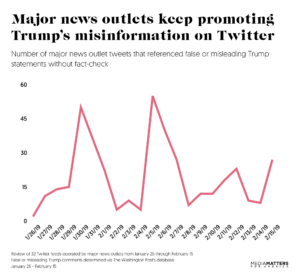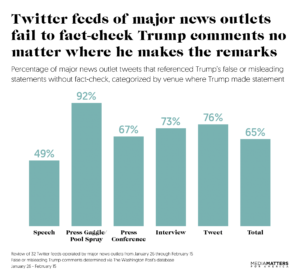#WorldPressFreedomDay ~ Media Matters
#WorldPressFreedom
#DefendMediaFreedom
“No democracy is complete without access to transparent and reliable information. It is the cornerstone for building fair and impartial institutions, holding leaders accountable and speaking truth to power.” — António Guterres, UN Secretary General
World Press Freedom Day was proclaimed by the UN General Assembly in December 1993, following the recommendation of UNESCO’s General Conference. Since then, 3 May, the anniversary of the Declaration of Windhoek is celebrated worldwide as World Press Freedom Day.
It is an opportunity to:
- celebrate the fundamental principles of press freedom;
- assess the state of press freedom throughout the world;
- defend the media from attacks on their independence;
- and pay tribute to journalists who have lost their lives in the line of duty.
https://www.un.org/en/events/pressfreedomday/
New @mmfa study: Major media outlets fail to debunk DT’s false or misleading statements in their tweets 65% of the time, amplifying his misinformation an average of 19 times per day.
“Why does this matter? Studies show 60% of Americans don’t read past the headlines, and the same proportion share tweets without clicking through. Media practices should reflect the way people consume news.”
Study: Major media outlets’ Twitter accounts amplify false DT claims on average 19 times a day
MATT GERTZ & ROB SAVILLO
Key Takeaways:
- 30% of the tweets by major media outlets’ Twitter accounts about DT remarks referenced a false or misleading statement.
- Nearly two-thirds of the time, the outlets did not dispute that misinformation.
- That means the outlets amplified false or misleading DT claims without disputing them 407 times over the three weeks of the study, an average of 19 times a day.
- The extent to which outlets’ Twitter feeds passively spread DT’s misinformation depended on the platform in which DT made his comments. For example:
- 92% of false or misleading DT claims went undisputed when he was speaking at a press gaggle or pool spray.
- 49% of false or misleading DT claims went undisputed when outlets were responding to comments he made during formal speeches.
- @TheHill was the worst actor and sent more than 40% of the tweets that pushed DT’s misinformation without disputing it during our entire study.
Major media outlets failed to rebut DT’s misinformation 65% of the time in their tweets about his false or misleading comments, according to a Media Matters review. That means the outlets amplified DT’s misinformation more than 400 times over the three-week period of the study — a rate of 19 per day.
The data shows that news outlets are still failing to grapple with a major problem that media critics highlighted during the Trump transition: When journalists apply their traditional method of crafting headlines, tweets, and other social media posts to DT, they end up passively spreading misinformation by uncritically repeating his falsehoods.
The way people consume information in the digital age makes the accuracy of a news outlet’s headlines and social media posts more important than ever, because research shows they are the only thing a majority of people actually read. But journalists are trained to treat a politician’s statements as intrinsically newsworthy, often quoting them without context in tweets and headlines and addressing whether the statement was accurate only in the body of the piece, if at all. When the politician’s statements are false, journalists who quote them in headlines and on social media without context end up amplifying the falsehoods.
Anecdotally, it’s been clear for some time that journalists have not adjusted their practices for the DT era in which, according to The Washington Post, DT has already made more than 10,000 false or misleading claims. In recent months, Media Matters has explored how news outlets have passively misinformed the public by passing along misinformation from DT administration figures on topics like threats of violence against journalists, special counsel Robert Mueller’s report, potential conflict with North Korea, Special Olympics funding, and whether the Obama administration was “spying” on Trump associates.
The news outlets that spread the most passive misinformation:
- The Hill
- ABC News
- CBS News
Other media Twitter feeds we reviewed that sent 10 or more tweets passing on false or misleading DT comments include MSNBC’s main feed (2.41 million followers, 11 such tweets, failing to dispute 55% of the time); NBC News’ main feed (6.52 million followers, 13 such tweets, failing to dispute 52% of the time); Politico(3.8 million followers, 14 such tweets, failing to dispute 58% of the time); and Roll Call (359,000 followers, 10 such tweets, failing to dispute 83% of the time).
Notable exceptions:
Some feeds entirely avoided passing on DT’s misinformation over the course of the study. NPR’s main feed, which tweeted only 20 times about Trump quotes, debunked the misinformation in all four false claims it tweeted about.
Other Twitter feeds limited the exposure their audience had to DT’s misinformation by minimizing their focus on DT’s comments. For example, the feed for Meet The Press, the NBC News Sunday political talk show, failed to dispute DT’s falsehoods 83% of the time. But it rarely tweeted about DT comments, with such tweets making up only 9% of the outlet’s total tweets about DT. CNN’s main Twitter feed similarly referenced DT quotes in only 11% of the tweets about him, while doing somewhat better at fact-checking Trump, disputing his false claims 75% of the time.
The Washington Post’s feed disputed DT’s misinformation at the highest rate of any feed we studied that tweeted about 10 or more false Trump claims. Out of 37 tweets about false or misleading TDT claims, the outlet disputed the misinformation 33 times and failed four times, a success rate of 89%.
Your newsroom might be small. You should still think big.
You’re not too small. Don’t think like it: The Herald got help from the Seattle Times to create a thoughtful commenting template, partnered with several community radio stations to publish the audio part of the project and created a resource site for the community that takes minimal maintenance.











Leave a Reply